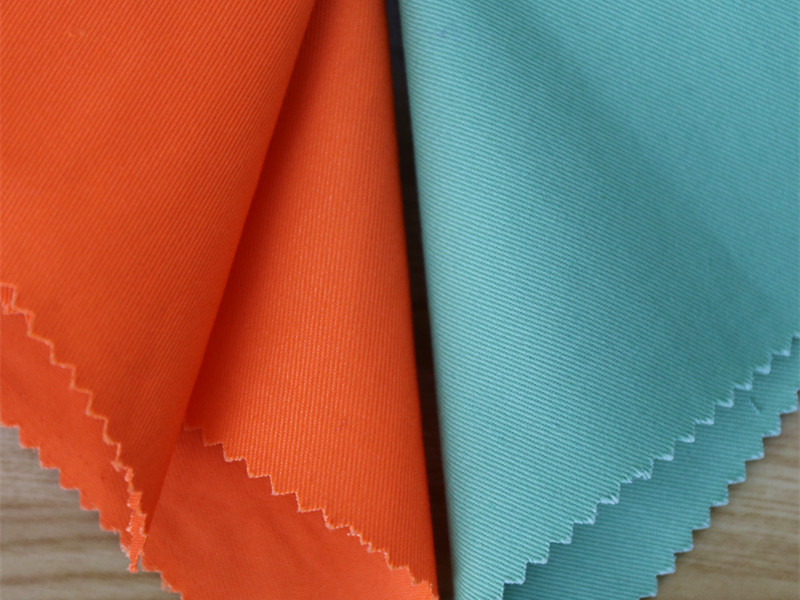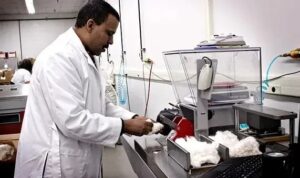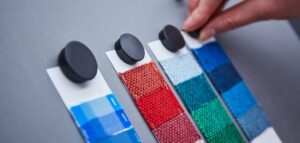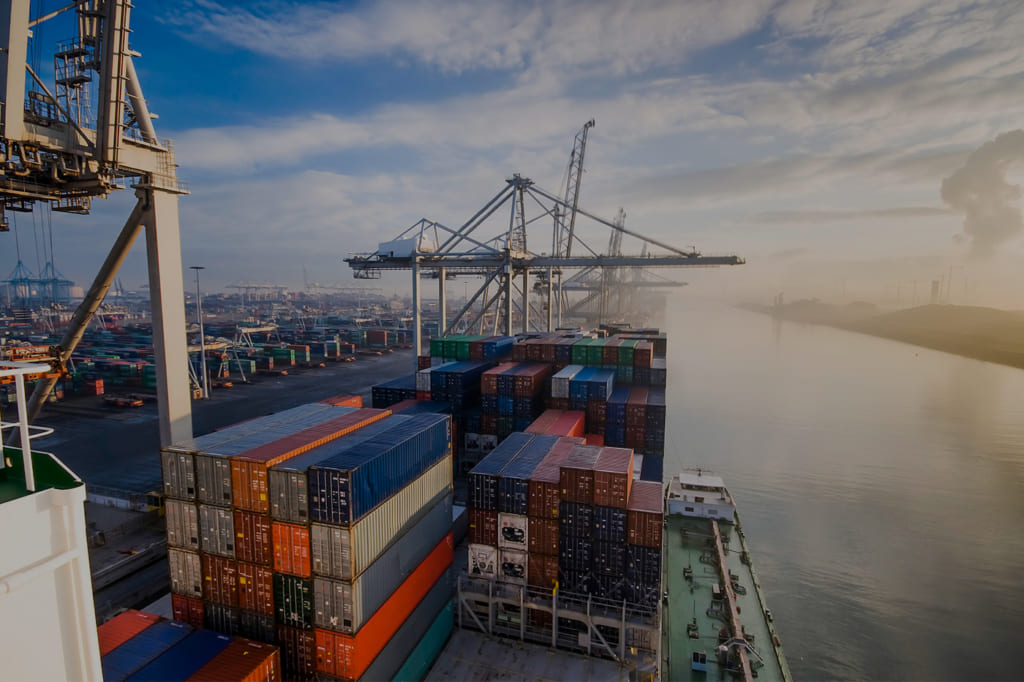What is Polyester Fabric?
Polyester fabric is a synthetic man-made fabric made from polyester fibers which are manufactured from a category of polymers made from oil. Polyester fiber is the most commonly used manufactured fiber worldwide.
Like other polymers, there are many variations of “polyesters.” The most popular is polyethylene terephthalate, or PET, which is widely used in both packaging and clothing. Polyesters are defined as (snooze alert!) long-chain polymers chemically composed of at least 85 percent by weight of an ester and a di-hydric alcohol and a terephthalic acid. The term refers to many (poly) esters (the building block compound—many fats and fragrances are esters).
The polyester fabric is one of the strongest fabrics with many qualities that make it suitable for manufacturing apparel and home furnishing and many items for industrial purposes. It may be knit or woven to make silk-like fabrics.
The History of Polyester Fabric
It was first manufactured in 1941 by Dupont and the first polyester fiber called Terylene.
In 1951 when the first U.S. Commercial Polyester Fiber Production was undertaken by the DuPont Company polyester was not much to write home about. But since then a lot has changed about polyester. By 2007 polyester has emerged as one of the most prominent fibers for fabric production – a decreased cotton production, as well as other natural fabrics, has led to polyester gaining unprecedented popularity in the fashion stakes.
In other words, Polyester plastic was discovered in a DuPont lab in the late 1930s, but scientist W. H. Caruthers set it aside to work on his newly discovered nylon. A group of British scientists applied Caruthers’ work in 1941 and created the first commercial polyester fiber in 1941 called Terylene. DuPont purchased the legal rights in 1946 and created another polyester fiber: the now familiar Dacron. Eastman Chemical created another polyester fiber in 1958 called Kodel.
The polyester fabric market rapidly expanded, to include by the late ’70s the ubiquitous and much maligned double knit polyester pantsuits, leisure suits, golf pants and other fashion atrocities.
Polyester Fiber
Most of the Polyester polymers are made by mixing ethylene glycol (derived from petroleum) and terephthalic acid. Terephthalic acid is also made from para-xylene, which is distilled from petroleum and then highly purified. The most common polyester for fiber purposes is polyethylene terephthalate(PET) which is used to make bottles.
To make polyester into fibers, the plastic is melt spun, meaning the plastic is heated and forced through spinnerets into fibers (a spinneret is essentially an industrial mechanism similar to a spider’s silk spinning organs). The fibers are stretched to five times their length, typically combined into yarn and then weaved or knitted into polyester fabrics.
Regardless the variation or the decade, polyester fabrics always have been strong, resistant to stretching and shrinking, easy to clean, quick drying and resistant to wrinkles, mildew and abrasions … a perfect combination for clothing.
Polyester Fiber is described as :
”A manufactured fiber in which the fiber-forming material is any long chain synthetic polymer composed of at least 85% by weight of an ester of a substituted aromatic carboxylic acid, including but not restricted to substituted terephthalate units, and para-substituted hydroxy-benzoate units.” in 2 Rule 7(c) of Federal Trade Commission of USA. You can find this info on page 2 of the document here.
More details on polyester production as found on the website of Tecnon Orbichem, a chemical data company
- Polyester (filament and staple) makes up 95%+ of future global synthetic fiber production growth
- Global polyester staple production growth during last five years 6.4%Production increases in 2012/13 for polyester staple production slowed significantly after above trend growth in 2010/11 due to cotton substitution
- As with polyester filament, China dominates with 65% of global production
What is Polyester Fabric used for?
Today polyester fabric is used to make affordable, functional, easily maintainable garments and to make low cost and easy to maintain home furnishings like bed sheets, upholstery covers, curtains.
A blend of cotton and polyester is used to make shirts, blouses and other clothes; the polyester /wool blend is good as suit fabric. 100% polyester is used to make upholstery cloth, awning fabric, jackets, lining. Polyester fiberfill is used as stuffing in cushions, comforters, mattresses, quilts, and pillows.
Monofilament thread used in sewing and embroidery is made with polyester fiber. Sewing thread made with polyester is very strong.
Polar fleece made with polyester fibers is used to make outdoor clothes. Pleated fabrics are almost always polyester
Characteristic qualities of the Polyester fabric.
Polyester is inexpensive
The topmost quality that trumps everything for the textile industry is the fact that polyester fabric is cheap compared to any other fabric. It is cheaper to produce. Polyester is made from crude oil and the decreased price of oil means that the production cost of polyester is low. Polyester/cotton-blended fabric is cheaper than 100% cotton.
Polyester is very strong and durable
Polyester fiber is counted as a very strong fiber. Straps made of polyester are said to be stronger than steel. It is not easily damaged by most chemicals/alcohol/oil. It is also resistant to stretching and shrinking when washed. It remains strong even when it is wet, unlike natural fibers. A major quality that I read everywhere about polyester is its abrasion resistance. It is also not damaged by sunlight
Polyester is lightweight and flexible
Though polyester is strong the fabric is very fine and lightweight. It also has some elasticity, though it is stable enough.
Polyester is easy to maintain
Polyester is easy to wash and clean and dries very quickly. It does not wrinkle easily and also may not need ironing if taken out from the washing machine immediately after washing/drying. In fact, during the early days of Polyester discovery, this was one of the selling points that Dupont company used – a fabric that does not need ironing.
It also resists mildew, moths, fungi and rot and cannot be damaged by insects. Polyester is somewhat stain resistant. Polyester clothing can also be dry cleaned.
You can learn more about details like whether Polyester will shrink.
Polyester retains creases when heat pressed
Polyester is the fabric most often used to make pre-pleated fabrics as it can be pressed into heat-set pleats without the use of chemicals. The quality of polyester to retain creases is called thermoplasticity.The best thing about pleated polyester fabric is that it remains soft even when heat is applied, unlike other fabrics.
More and more advances in technology result in polyester fabric with many desirable qualities that one would expect from a high quality highly used fabric -like sweat-wicking, the addition of anti-static fibers, and flame-retardant fibers.
Polyester is recyclable
The polyester can be recycled to form new fibers. Polyester fiber, yarn and fabric can be recycled.
Polyester has a high melting point
Polyester shows high resistance to heat. It does not burn with high heat till about 200-degree Celsius, even then it only softens and never burns, which is in contrast with natural fabrics which can burn easily with heat and hence they are reported to be unsuitable for making sleepwear for kids.
Polyester is non-absorbent
This quality is useful in making athletic apparel as it will manage moisture /sweat by wicking it away from the body during strenuous activity, keeping the body comfortable. Polyester microfiber is such a fabric that allows moisture to wick to the surface and quickly evaporate.
Disadvantages of Polyester fabric
Some people love to only wear or use natural fabrics and yarns, such as cotton, cashmere, silk, wool etc. The benefits to these are they are generally breathable, hypoallergenic, and durable. They can also be more expensive than manmade fibres and need more care in regards to washing and drying.
The main issue regarding synthetic fabrics, such as polyester, is that they don’t breathe. Some find, when wearing it, that they can feel sweaty or have a feeling of humidity, which can be uncomfortable. This is because the moisture absorption of polyester is very low, compared to natural fabrics like cotton. However, modern manufacturing is now starting to create more moisture-wicking polyesters, which are great for work out and leisurewear.
People with very sensitive skin might find that they get a small reaction to wearing synthetic fabrics, however, this is usually not as common when it is a blended fabric.
On its own, it is highly flammable, so care needs to be taken, especially if wearing or using 100% polyester near an open flame.
As polyester is made from plastic, there is the question as to whether it is bad for the environment. True, it does come from an unsustainable source, however, plastic bottles are actually recycled into polyester fabric, which is pretty amazing, but, on the downside, plastic is not compostable, which means it doesn’t break down well in soil.
There are many other more serious disquietening things about polyester – especially the fact that the production of this fabric involves high energy consumption and toxic emissions. The fact that the oil required for making Polyester is a non-recoverable resource is something to think about.
Dye carrier used to dye polyester fabrics is supposed to be toxic to humans. Polyester is dyed with disperse dyes and the process uses a carrier which facilitates better dye absorbtion – this is supposed to be toxic.
When cotton is blended with polyester the resultant fabric pills a great deal. This is also true for other blends of polyester like rayon/polyester blends. Read more about tips to prevent pilling here.
Another disadvantage of polyester as a dressmaking fabric is that it is not breathable like natural fabrics. So when you wear a polyester garment you will not be as comfortable. But newer innovations like Polyester microfiber are changing this aspect. Microfiber fabric can wick moisture and is breathable and comfortable
The worst thing about Polyester is that it does not decompose, but remains in the soil for many many years.
Is Polyester fabric a bad or good option?
I have been wary of buying anything in polyester because of this ethical conscience thought lingering in my mind that maybe I am doing something good to the landfills in not buying polyester fabric.
But now I ease my mind by saying that if the production process of polyester is bad, then this is so for all processes in the textile industry, even for natural fabrics. And Polyester can be recycled, which cannot be said about any other fiber.
Today polyester has replaced even cotton as the most popular fabric made on this earth – and I know I cannot take a vow ‘not-to-buy-polyester-ever’ anymore. It is already there in many of our clothes and accessories – as a lining material, as straps, as trims, or masked after being blended with natural fibers.
You may not ‘love-or-dislike’ Polyester but you cannot ignore it anymore.
“Polyester is a non-biodegradable fabric which can take up to 20-200 years to decompose”. This statement that I recently read in a science book has colored all my subsequent clothing purchases. But my conviction, wrong or otherwise, does not matter to the world and Polyester today is one of the top fabrics for making clothes.
OUR VERDICT:
It is undeniable that polyester fabric has a huge variety of beneficial uses, in a wide variety of sectors. As with any synthetic material, reactions can occur, but these are vastly limited, especially when polyester is blended with other fibres, such as cotton. Adverse reactions to fabrics and textiles (even natural ones) are always a possibility, but overall, the use of polyester can be extremely beneficial and useful.
Polyester has a lot of stigma, due to the old-fashioned polyester, which was super popular in the 1970’s, but fell from grace thanks to the uncomfortable double-knit polyester fabric. However, modern polyester has come on in leaps and bounds and is now a higher-grade fibre. Technological advances have dramatically improved the feel, drape and look of polyester, so it blends right in with more natural and expensive fabrics. As with all synthetics, it will remain, to an extent, unbreathable, so for anyone who experiences hot flushes, excess body heat or lives in a humid environment, polyester might not be the best fabric option for you.
Modern polyesters can feel and look as beautiful as real silk and wool, but it is all about ensuring you opt for a high-grade version or the right blend. A lot of high end brands use polyester in their collections, mainly to increase durability, ease of care and exciting effects.
It is all about being savvy when it comes to choosing your fabric. Remember, not all polyesters are created equal. Do your research, check labels, and always try on and there is no reason you and polyester can’t be friends.
How Polyester Fabric Has Changed Through the Years
So why did some ’70s leisure suit fabrics feel different than today’s polyesters? Mostly it was the double knit nature of the polyester fabric used in those suits and the relatively larger size of the fibers.
In reality, there were many wonderful polyester fabrics in the ’70s. The choice of fabric rested with the garment maker, who often wanted to keep down costs. And since trends during the economically challenging late ’70’s were toward saving money and living less formally, many Americans were attracted to the very inexpensive leisure suit. (I never was. I swear.)
Polyester Today: A Modern Fabric for Savvy Consumers
Today’s consumer (mercifully) demands better. And innovations in technology continue to improve polyester fiber and fabric through:
- Refinements in production of the resin (usually highly guarded trade secrets);
- Changing the shape of the spinneret, which changes the shape and feel of the fiber;
- Stretching the polyester fiber beyond the typical five times its original length;
- Crimping the polyester fiber to create more texture and bulk for insulating and elasticity;
- Various additives that alter the polyester fabric’s sheen, increase colorfastness, improve drape and more; and
- The creation of microfiber, extremely fine fibers approximately 1/100 the diameter of human hair that are used in all sorts of fabrics and clothing (and many other applications).
The cultural backlash against the leisure suit (and disco, for that matter) struck a blow to the image of polyester fabric. However, studies done in the early ’80s found that nearly nine out of 10 Americans could not differentiate between polyester and fabrics made with cotton, wool and silk.
Frankly, people have become more interested in the look, feel and cost of fabrics and clothing, not necessarily what they are made of. Constantly improving quality coupled with a “Say Yes to polYESter” marketing campaign led to a strong comeback for the once disparaged material.
Polyester Fabric Trends and Innovations
And it’s not simply for casual clothes anymore. Most Americans probably don’t know this, but polyester and other plastic based fabrics are used throughout the high-end fashion world. Instead of identifying the materials, designers often use euphemisms such as “technical fabrics” and “techno fabrics.” Whatever. These fabrics are made with plastics, one of which is so light that a bolt of fabric weighs less than the cardboard roll it’s delivered on.
Similar polyester and other plastic based fabrics have taken the sporting and outdoor worlds by storm. Wander through any sporting goods store or outdoor outfitter and check the tags—nearly all plastics.
So go ahead and make fun of your dad’s leisure suit—or your own. But celebrate the resurgence of a superb product … and say YES to polyester fabrics.
Read More:
Polyester Fiber and Polyester Fabric: Definition and Uses
Where to buy Recycled Polyester Fabric in China and Viet Nam





